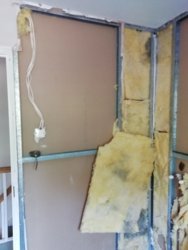Regarding the floor, I would use a decent quality ply wood (18mm) exterior grade. Wickes sell it. And then glue and screw HB onto this. Then tape the joints.
We spend our lives advising against using materials that expand and contract with atmospheric conditions or copious amounts of water, British Standards have just been amended the guidelines to eliminate ply walls , and floors are just a matter of time.
So why do we still want to fit ply and then overboard it!
That’s two processes, good quality ply (contradiction in terms) barely exists, and marine ply although the correct material is extremely rarely used.
And then you want to do it all over again by overboarding with a cement board that needs glueing, screwing and the joints taping.
And that is NO guarantee that movement cracks won’t transfer thro. It happens all too regularly.
Any gypsum structural board goes straight to joist, is primed and then tiled and has a lower profile overall.
I’m not digging you out in particular Andy (waluigi) cos it’s said all the time.
I just struggle to understand the logic behind it.
And as far as existing boards going beneath stud walls are concerned, most plunge saws will cut within 15mm of a wall, so I don’t teally see that as an excuse either.
If you’re gonna strip everything back and start again, why put the same bloody stuff back again.
It really doesn’t make sense to me.
And breath.......
🙂

